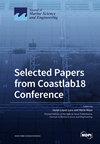不同系泊点方形裙边锚的承载能力研究
IF 2.8
3区 地球科学
Q1 ENGINEERING, MARINE
引用次数: 0
摘要
裙带锚通常用作水下管道和浮动平台的临时或永久锚固基础。为了研究不同系泊点的方形裙边锚的承载能力,我们进行了一系列模型试验和有限元模拟。根据试验结果,分析了不同系泊点的方裙锚的两种失效模式。结果发现,当锚泊点位于侧裙顶部时,方裙锚更容易发生旋转,承载能力也更低。模型试验对数值方法进行了验证。总计 140 项数值计算结果表明,当锚泊点位置(锚泊点归一化深度)h/H = 0.5~0.75 和荷载倾角 θ = 0°~30° 时,方裙锚的承载性能最佳。当方形裙边锚的长宽比(H/B)从 0.25 增加到 2.0 时,最佳系泊点位置 h/H 从 0.5 向下移动到 0.75。绘制了方形裙边锚 V-H 负载空间的破坏包络线,并得到了相应的拟合方程。本文章由计算机程序翻译,如有差异,请以英文原文为准。
A Study on the Bearing Capacity of Square Skirted Anchors with Different Mooring Points
Skirted anchors are often used as temporary or permanent anchoring foundations for underwater pipelines and floating platforms. A series of model tests and finite element simulations were conducted to study the bearing capacity of square skirted anchors with different mooring points. Based on the test results, two failure modes of square skirted anchors with different mooring points were analyzed. It was found that, when the mooring point was located at the top of the side skirt, the square skirted anchor was more prone to rotation and had a lower bearing capacity. The numerical method was validated by the model tests. In total, 140 numerical calculation results show that, when the mooring point position (normalized depth of mooring point) h/H = 0.5~0.75 and the load inclination angle θ = 0°~30°, the bearing performance of the square skirted anchor is optimal. As the aspect ratio of the square skirted anchor (H/B) increases from 0.25 to 2.0, the optimal mooring point position h/H moves downward from 0.5 to 0.75. The failure envelopes in the V-H loading space of the square skirted anchor were drawn, and the corresponding fitting equation was obtained.
求助全文
通过发布文献求助,成功后即可免费获取论文全文。
去求助
来源期刊

Journal of Marine Science and Engineering
Engineering-Ocean Engineering
CiteScore
4.40
自引率
20.70%
发文量
1640
审稿时长
18.09 days
期刊介绍:
Journal of Marine Science and Engineering (JMSE; ISSN 2077-1312) is an international, peer-reviewed open access journal which provides an advanced forum for studies related to marine science and engineering. It publishes reviews, research papers and communications. Our aim is to encourage scientists to publish their experimental and theoretical results in as much detail as possible. There is no restriction on the length of the papers. The full experimental details must be provided so that the results can be reproduced. Electronic files and software regarding the full details of the calculation or experimental procedure, if unable to be published in a normal way, can be deposited as supplementary electronic material.
 求助内容:
求助内容: 应助结果提醒方式:
应助结果提醒方式:


